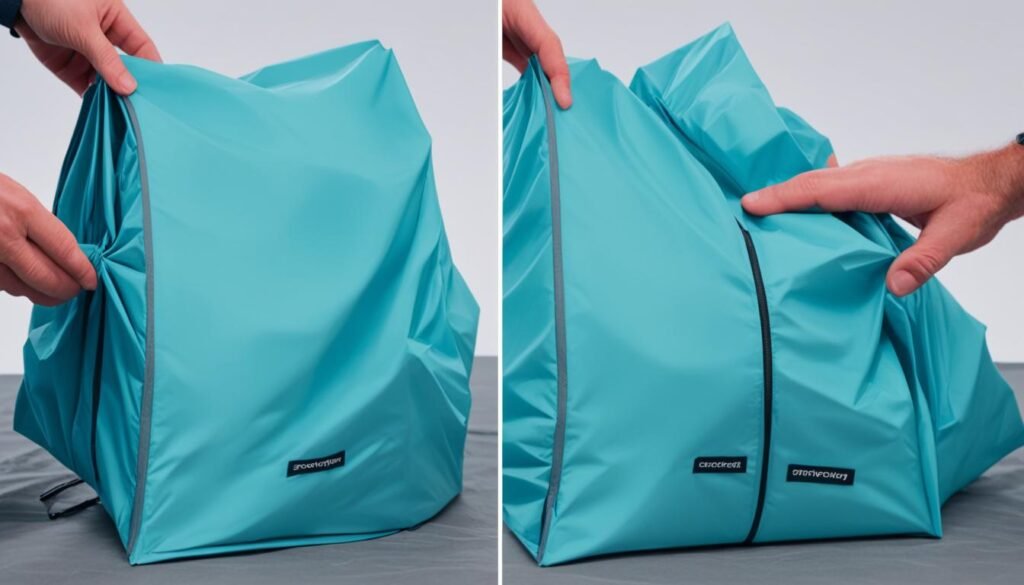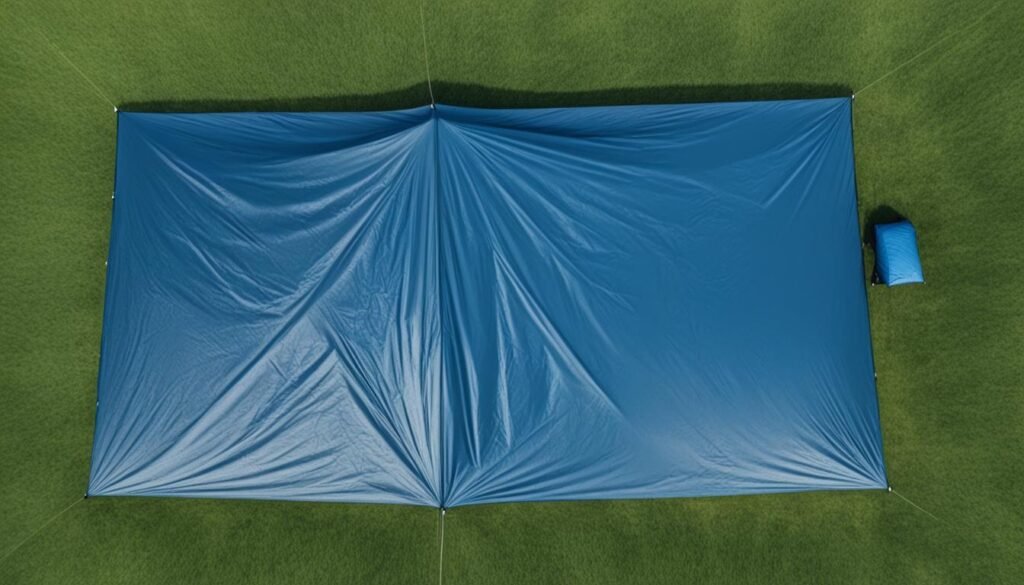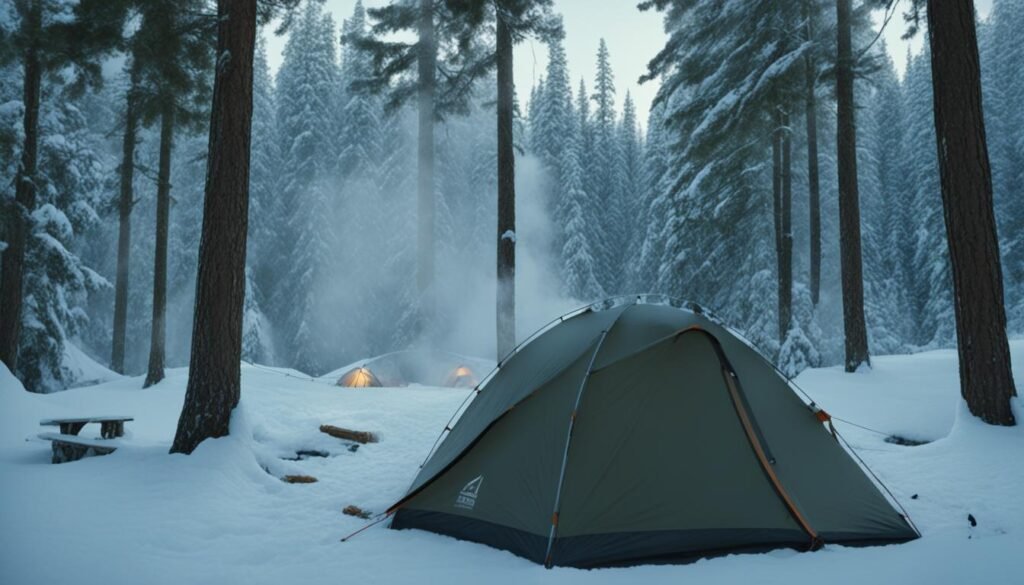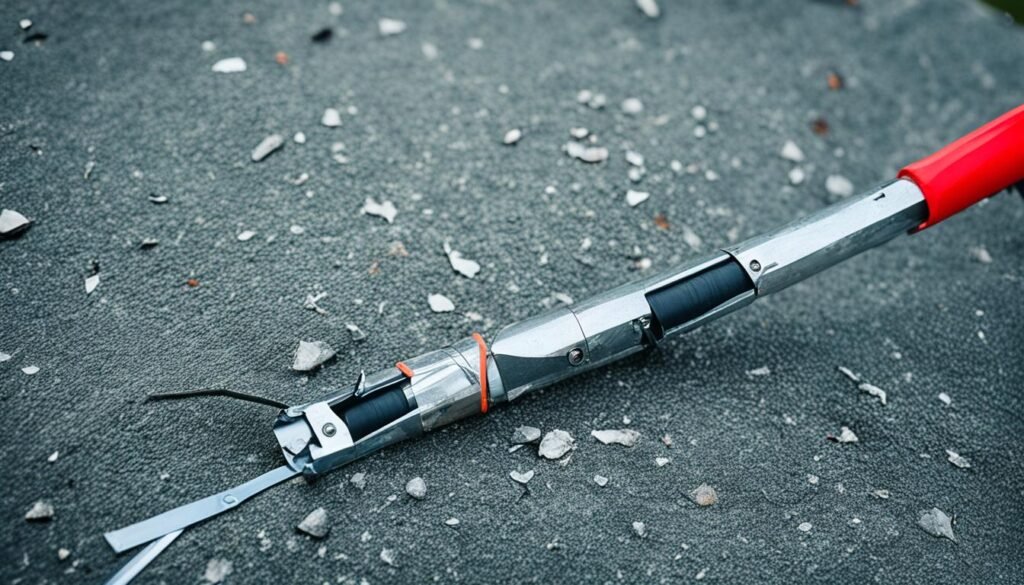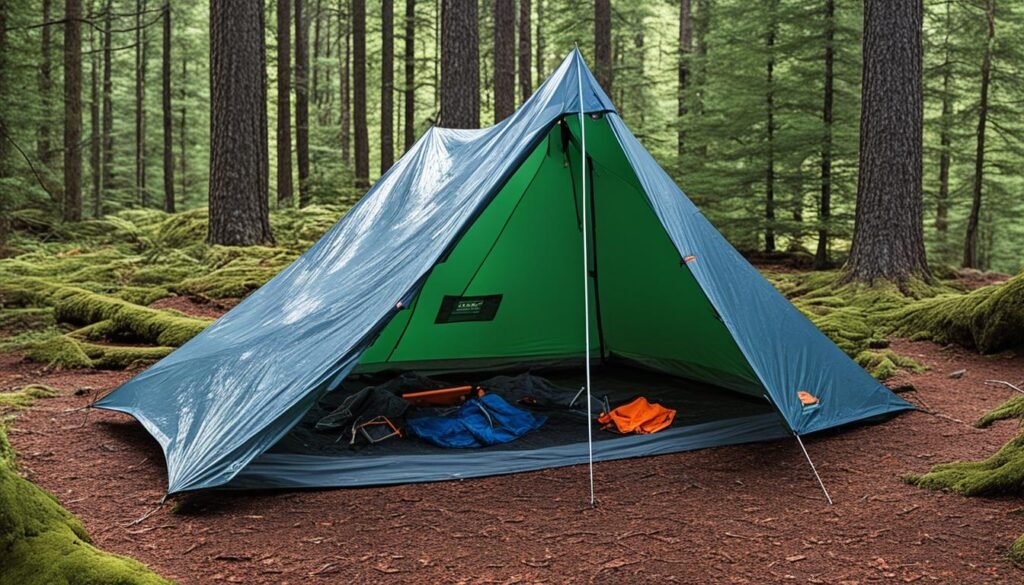Mastering the skill of properly folding and storing a tent is essential for any camping enthusiast. Not only does it maximize storage space, but it also ensures the longevity of your tent and simplifies the setup process for your next outdoor adventure. In this comprehensive guide, I will walk you through the step-by-step process of folding a tent and packing it away neatly in its bag. With these techniques, you’ll be able to efficiently breakdown and store your tent, ready for your next camping trip.
Key Takeaways:
- Properly folding and storing your tent maximizes storage space and maintains the tent’s condition.
- Start by cleaning and drying the tent before beginning the folding process to prevent mold and mildew growth.
- Remove the pegs and poles in the correct order, ensuring a smooth breakdown process.
- Double-check for any remaining pegs, clean the poles and pegs if necessary, and detach the ropes or straps before folding.
- Follow the recommended folding techniques, such as half-folding and back-folding, to compactly fold your tent.
Preparing Your Tent for Packing
Before you start the process of folding your tent and packing it away, it is crucial to prepare the tent properly. Taking a few simple steps will help ensure that your tent remains clean, dry, and free from mold and mildew growth.
To prepare your tent for packing:
- First, shake off any loose dirt or debris from the tent. It’s important to remove as much dirt as possible to prevent it from collecting inside the tent while it’s packed away.
- If your tent is damp, it’s essential to allow it to thoroughly air-dry before packing it. Moisture trapped inside the tent can lead to mold and mildew growth, which can damage the fabric over time.
- Gently shake the tent to remove any remaining dirt or debris.
- To prevent mold and mildew growth during storage, make sure the tent is completely dry before packing it away. Check the tent body, rainfly, and any attachments to ensure they are free from moisture.
By properly preparing your tent before packing, you can help extend its lifespan and ensure that it’s in excellent condition for your next outdoor adventure.
Expert Tip
Always make it a habit to shake off any dirt or debris from your tent before packing it away. It’s a small step that can make a big difference in keeping your tent clean and in good condition.
Removing the Pegs and Poles
When it’s time to pack up your tent, the first step is to remove the pegs and poles. This ensures a smooth disassembly process and makes folding the tent much easier. Here, I’ll guide you through the proper methods for removing pegs and poles, so you can efficiently dismantle your tent.
To begin, start by removing all the outer pegs from the ground. This can be done by firmly gripping the peg near the base and pulling upwards with a slight twisting motion. If the ground is particularly hard or the pegs are stuck, you may need to employ alternative methods.
- Twist and Pull Method: For stubborn pegs, you can use the “twist and pull” technique. Simply twist the peg clockwise or counterclockwise to loosen it, and then pull it out of the ground.
- Peg Extractor: Another useful tool is a peg extractor. This specialized tool is designed to easily remove pegs from the ground, even in challenging conditions. Simply insert the peg extractor around the peg’s head, apply pressure, and lift to remove the peg.
Once all the pegs are removed, it’s time to tackle the poles. The order in which you remove the poles may vary depending on your tent’s design, but it’s generally recommended to start from the outside and work inwards. This ensures that the tent remains stable as you disassemble it.
Pro Tip:
If you’re uncertain about the proper order for removing the poles, refer to your tent’s instruction manual or consult the manufacturer’s website for guidance specific to your tent model.
| Peg Removal Methods | Pros | Cons |
|---|---|---|
| Twist and Pull Method | – Simple and requires no additional tools – Can be done with bare hands |
– May not be effective on extremely hard ground – Requires physical effort |
| Peg Extractor | – Specially designed tool for easy peg removal – Works well in challenging conditions |
– Additional tool to carry – Requires proper technique for effective use |
Note: The effectiveness of each method may vary depending on the condition of the ground and the type of pegs used.
By following these methods for removing pegs and poles, you can ensure a smooth and efficient disassembly process. With the pegs and poles safely removed, you’re ready to move on to the next steps of folding and packing your tent.
Final Checks Before Folding
After removing the pegs and poles, it is crucial to perform final checks before folding your tent. These checks ensure that your tent is clean, dry, and properly prepared for storage.
Remove Remaining Pegs
Double-check the ground to make sure that all pegs have been removed. Leaving pegs behind can cause damage to the tent fabric and create difficulties when setting up your tent during the next camping trip. Take the time to carefully inspect the camping area and remove any remaining pegs.
Cleaning Poles and Pegs
Before folding your tent, it is a good idea to clean the poles and pegs. Dirt and debris can accumulate on these components, potentially causing damage or hindering their functionality over time. Give the poles and pegs a thorough wipe down using a damp cloth or towel to remove any dirt or grime. This small maintenance step will help prolong the lifespan of your tent equipment.
Towel Drying
If the poles and pegs are wet or damp, towel drying them is essential. Moisture on the poles or pegs can lead to rusting or the growth of mold and mildew. Use a clean towel or cloth to dry each component thoroughly. Make sure to pay extra attention to crevices and hard-to-reach areas. Properly dried poles and pegs will contribute to the longevity of your tent and ensure a pleasant camping experience.
Detach Ropes If Necessary
Prior to folding your tent, check the condition of the ropes or webbing straps. If they are wet or damp, detach them from the tent to allow for proper drying. Wet or damp ropes can cause dye transfer or mildew due to friction during folding. Once detached, hang them in a well-ventilated area to air dry completely. Detaching the ropes if necessary will prevent any potential damage or unpleasant surprises when you next use your tent.
Visual Guide: Final Checks Before Folding
Folding the Tent
When it comes to folding your tent, there are a few key considerations to keep in mind. First and foremost, make sure you are not standing on the fabric while folding, as this can cause unnecessary damage. Instead, find a clean and dry area to work on.
To begin the folding process, start by folding the tent in half. This can be done by collapsing one half of the tent onto the other, ensuring that the doors and windows are aligned. By folding in half, you create a more manageable size for the next step.
Next, fold the tent back onto itself. This can be done by bringing one end of the tent towards the other, aligning the edges and corners as you go. The goal is to create a compact and uniform package.
One important consideration during the folding process is the care of the fabric. It’s essential to ensure that the ropes or webbing straps are dry before folding. If they are damp or wet, they can cause dye transfer or even mildew due to friction. Take the time to thoroughly dry them before proceeding.
Another helpful tip is to temporarily detach the ropes if necessary. This can prevent tangling and make the folding process smoother. However, be sure to reattach them securely before storing the tent.
To ensure that your folded tent will fit back into its bag, try placing the bag at the end of the tent. Assess whether the width is small enough to allow for easy storage and transportation. If necessary, adjust the folding technique to achieve the desired size.
Remember, proper folding not only saves space but also helps to protect the fabric and keep your tent in good condition. Take care when handling and folding, and your tent will last for many adventures to come.
Folding Methods Comparison
| Folding Method | Advantages | Disadvantages |
|---|---|---|
| Half-Folding | – Compact size – Uniform shape |
– Requires more effort |
| Back Folding | – Easier to achieve compactness – Neater finish |
– May result in more creases |
| Rope or Strap Detachment | – Prevents tangling – Easier handling |
– Requires reattachment before storage |
Final Folding Stage
Once the tent has been folded in half, it’s time to proceed to the final folding stage. This step involves lengthwise folding, utilizing the roll and release technique, ensuring tent tightness, and using clips to keep it compact.
To begin, fold the tent in half lengthwise. This additional fold helps to further reduce the size and length of the tent, making it easier to store and transport.
Next, smooth the tent fabric and release any trapped air as you roll it tightly. Rolling the tent tightly not only saves space but also minimizes the chances of creases and wrinkles in the fabric, ensuring a more organized and manageable setup for your next camping adventure.
When rolling the tent, you can start from the open end for a neater finish. However, if you’re looking for maximum efficiency in releasing air, consider rolling from the opposing end. This technique allows air to be expelled more effectively, resulting in a tighter roll and easier storage.
After rolling the tent, it’s important to secure it in place to maintain its compactness. Many tents come with provided straps or clips specifically designed for this purpose. Use these straps to clip the rolled-up tent tightly, preventing it from unraveling during transportation or storage.
If you require additional storage space, consider investing in an “XL Kit Bag” or a similar solution. These larger-sized bags offer ample room for your tent and any additional accessories, making it easier to keep everything organized and protected.
If you follow these final folding techniques, you’ll be able to pack your tent into its bag efficiently and ensure that it remains compact, secure, and easy to transport.
Putting the Tent in the Bag
When it comes to stowing away your tent, it’s essential to ensure that it fits back into the bag properly. Here are some tips to help you pack your tent efficiently:
- Start by placing the bag at the end of the tent.
- Check if the width of the tent is small enough to fit into the bag.
- If the tent doesn’t fit, you may need to adjust the folding technique. Try different folding methods until the tent is compact enough to fit comfortably into the bag.
- Remember to use a bag that is properly sized for your tent. Using a bag that’s too small can put unnecessary stress on the fabric and zippers, potentially causing damage.
By following these tips, you can ensure that your tent is neatly packed away and ready for your next adventure.
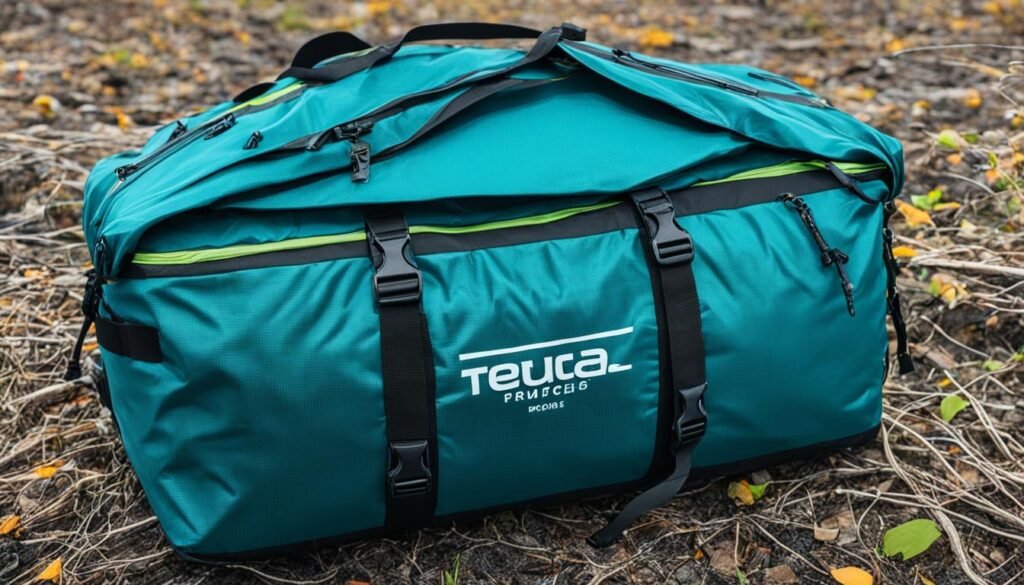
| Tent Size | Recommended Bag Size |
|---|---|
| 1-2 Person Tent | Small (45-55 liters) |
| 3-4 Person Tent | Medium (55-75 liters) |
| 5-6 Person Tent | Large (75-100 liters) |
| 7+ Person Tent | X-Large (100+ liters) |
Drying the Tent Before Storage
Storing a wet or damp tent can pose various risks, including the growth of mold and mildew, fabric degradation, stains, and foul smells. To ensure the longevity and performance of your tent, it is crucial to properly dry it before storing. Here are some essential steps to follow:
- Shake off any loose dirt or debris: Before drying the tent, give it a good shake to remove any dirt or debris that may have accumulated.
- Air dry in a well-ventilated area: Find a well-ventilated area, preferably outdoors, to hang the tent and let it dry naturally. This will allow air circulation and aid in the drying process.
- Ensure the tent is completely dry: It is essential to make sure both the tent body and rainfly are completely dry before storing. Check for any moisture or damp spots, as even a small amount can lead to mold or mildew growth.
Properly drying your tent not only prevents the growth of mold and mildew but also helps maintain the fabric’s integrity and prevents the formation of stubborn stains and foul smells. By following these steps, you can ensure that your tent remains in optimal condition for your next camping adventure.
“Storing a wet or damp tent can lead to several issues, including the growth of mold and mildew, fabric degradation, stains, and foul smells.”
| Risks of Storing a Wet or Damp Tent | Prevention |
|---|---|
| Mold and Mildew Growth | Ensure thorough drying before storage |
| Fabric Degradation | Avoid storing a damp tent |
| Stains and Mildew Spots | Shake off dirt and debris before drying |
| Foul Smells | Air dry in a well-ventilated area |
Checking for Damage and Repairing
Before packing the tent away, it is important to conduct a thorough inspection to identify any damage that may have occurred during your camping trip. Inspecting the tent will allow you to address any issues before storing it, ensuring that it is in optimal condition for your next adventure. Here are the steps you should follow:
- Start by examining the tent fabric, paying close attention to seams, corners, and high-stress areas. Look for any signs of rips, tears, or punctures.
- Check the tent poles for any signs of damage, such as bends, cracks, or splintering. Ensure that all pole segments are intact and securely connected.
- Inspect the zippers to ensure they are functioning properly. Test each zipper to ensure they move smoothly without snagging or sticking.
- Examine the tent’s guylines, stakes, and other hardware. Look for any signs of wear or damage, such as fraying or bent components.
If you discover minor damage, such as small tears or holes in the tent fabric, you can easily repair them using a tent repair kit or duct tape. Follow the instructions provided with the repair kit or apply duct tape to the damaged area, ensuring a secure and watertight seal.
Note: It is important to address minor damage promptly to prevent it from worsening and compromising the tent’s performance. Repairing small issues before they escalate can save you from having to replace larger parts or the entire tent.
However, if you find significant damage that cannot be repaired or if multiple areas of the tent are compromised, it may be necessary to replace certain parts or even the entire tent. Consult the manufacturer’s guidelines for replacement parts or consider reaching out to a professional for assistance.
| Damage | Repair | Replacement |
|---|---|---|
| Rips or tears in fabric | Use tent repair kit or duct tape | Replacement fabric panels |
| Bent or cracked poles | Repair with splint or replace individual segments | Full pole replacement |
| Broken zippers | Apply zipper repair kit or replace zipper sliders | Zipper replacement |
| Damaged guylines or stakes | Repair with knotting techniques or replace individual components | Replacement guylines or stakes |
Choosing Between Folding and Stuffing
The choice between folding and stuffing a tent depends on personal preference and the type of tent you have. Both methods have their advantages and disadvantages, and it’s important to consider them before deciding which one works best for you.
Folding
Advantages of Folding:
- Neat and organized: Folding the tent can result in a compact and tidy package.
- Minimizes creases and wrinkles: Proper folding techniques help to minimize the appearance of creases and wrinkles in the tent fabric.
- Easier to manage: A folded tent is easier to handle and store, especially if you have a dedicated tent bag with specific dimensions.
Disadvantages of Folding:
- Takes time and practice: Properly folding a tent requires practice and can take some time, especially if it’s your first time doing it.
- Requires space: Folding a tent requires a relatively large open space, which may be a challenge if you have limited room available.
Stuffing
Advantages of Stuffing:
- Quick and convenient: Stuffing a tent is a faster and more convenient method, especially when you’re in a hurry or dealing with unfavorable weather conditions.
- No precise folding required: Unlike folding, stuffing a tent doesn’t require precise folding techniques, making it easier for beginners or campers with limited time.
- Flexible to fit any shape: Since there’s no specific folding technique involved, you can adjust the tent’s shape to fit any available storage space.
Disadvantages of Stuffing:
- Increased risk of damage: Stuffing a tent haphazardly may increase the risk of damaging the fabric, particularly if it’s forced into a small storage space.
- Potential creasing and wrinkling: Stuffing a tent without proper alignment or care can lead to creases and wrinkles in the fabric, which may be more difficult to remove during the next setup.
Consider your personal preferences, the specific tent you have, and the available storage space when deciding whether to fold or stuff your tent. Remember, the goal is to store it efficiently while ensuring the longevity and performance of your outdoor gear.
Proper Storage After Camping
Properly storing your tent after camping is essential to extend its lifespan and maintain its condition. Follow these steps to ensure your tent is ready for your next adventure:
Cleaning and Drying
Before storing your tent, make sure it is clean and dry. Shake off any dirt or debris, and if the tent is damp, allow it to air-dry completely. This step is crucial to prevent mold and mildew growth, which can damage the fabric over time.
Removing Stakes and Guy Lines
Take the time to remove all stakes and guy lines from the tent. This prevents them from getting tangled or causing damage during storage. It also helps prepare the tent for folding or rolling.
Folding or Rolling the Tent
Choose whether to fold or roll your tent based on personal preference and the type of tent you have. Make sure to fold or roll it tightly to save space and prevent wrinkles. Remember to detach any removable parts, such as rainfly or tent poles, and store them separately if necessary.
Storing in a Cool and Dry Place
Find a cool, dry, and well-ventilated place to store your tent. Avoid storing it in damp basements or airtight containers, as moisture buildup can cause damage. A dry and cool environment prevents mold, mildew, and fabric degradation.
Using a Storage Bag or Sack
Consider using a storage bag or sack specifically designed for tents. These bags provide protection and allow for proper air circulation, preventing the growth of mold and mildew. Ensure the bag is of an appropriate size for your tent, so it fits snugly without excessive compression.
Tent Storage Comparison
| Folding | Rolling | |
|---|---|---|
| Advantages |
|
|
| Disadvantages |
|
|
Properly storing your tent after camping ensures it remains in good condition and ready for your next outdoor adventure. By following these steps and using the right storage methods, you can prolong the lifespan of your tent and maximize its performance.
Tips for Proper Tent Storage
In addition to proper storage after camping, it is important to periodically check on your stored tent to ensure it remains dry and in good condition. By taking a few simple measures, you can protect your tent and prolong its lifespan, ensuring it’s always ready for your next outdoor adventure.
Periodic Checks
Regularly inspect your stored tent to identify any signs of damage or deterioration. Look for tears, holes, or weak spots in the fabric, as well as any issues with the poles or zippers. Addressing these problems promptly can prevent further damage and ensure your tent is always in optimal condition.
Preventing Pests
To keep pests like rodents and insects from making a home in your tent while it’s in storage, take precautions to create a pest-free environment. Store your tent in a sealed container or bag to prevent access, and consider adding deterrents such as mothballs or cedar chips. These steps will help protect your tent from unwanted visitors and potential damage.
Avoiding Excessive Compression
When storing your tent, avoid excessive compression that can cause unnecessary stress on the fabric and waterproof coatings. Folding or rolling the tent too tightly can lead to creases, weaken the fabric, and compromise its performance over time. Find a balance between keeping the tent compact and allowing enough room for the fabric to breathe.
Keeping Away from Direct Sunlight
Direct sunlight can cause UV damage to the fabric of your tent, leading to fading, weakening, and degradation. To protect your tent from prolonged sun exposure, store it in a cool, dry place away from direct sunlight. This will help preserve the quality and color of the fabric, extending the lifespan of your tent.
Remember, proper tent storage is essential for maintaining the longevity and performance of your tent. By following these tips for regular checks, preventing pests, avoiding excessive compression, and keeping the tent away from direct sunlight, you can ensure that your tent remains in excellent condition, ready for your next adventure.
Dealing with Damaged Tent Bags
When it comes to outdoor adventures, our trusty tent bags often bear the brunt of heavy weight loads and harsh environmental conditions. Over time, this can lead to wear and tear, leaving your tent bag damaged and less effective in protecting your gear. However, the importance of a reliable tent bag should not be underestimated, as it plays a crucial role in safely transporting your tent and preventing damage to the fabric. In this section, I will discuss the significance of a sturdy tent bag, explore alternative methods for transporting your tent without a bag, and provide insight into repairing or replacing a damaged tent bag.
The Importance of a Tent Bag
Having a proper tent bag is essential for safeguarding your tent and maintaining its longevity. Here’s why:
- Protection: A durable tent bag shields your tent from external elements such as dirt, debris, moisture, and UV rays. It acts as a barrier, preventing these elements from causing damage or discoloration to the fabric.
- Convenience: A well-designed tent bag provides a convenient and organized way to transport your tent. It keeps all the components in one place, making it easier to carry and store.
- Prolonged Lifespan: By securely housing your tent, a quality bag minimizes the risk of accidental tears, punctures, or misplaced accessories. This ensures that your tent remains in optimal condition, ready for your next adventure.
However, if your tent bag has fallen victim to wear and tear, fear not. There are several options available for repairing or replacing it.
Transporting a Tent without a Bag
If you find yourself without a tent bag, there are alternative methods for safely transporting your tent:
- Reusable Storage Containers: Consider using air-tight storage containers or duffel bags as an interim solution. Ensure the container is clean, dry, and spacious enough to accommodate your tent and its components.
- Compression Straps or Bungee Cords: Use compression straps or bungee cords to secure the tent and its poles together before transport. This method helps keep everything compact and prevents tangling or damage during transit.
- Utilize a Spare Bag: If you have a spare bag large enough to accommodate your tent, use it as a temporary solution. While not specifically designed for tents, it provides a practical and protective means of transport.
Remember, while these alternatives may be effective in the short term, investing in a purpose-built tent bag is always the best long-term solution.
Repairing or Replacing a Damaged Tent Bag
If your tent bag has suffered damage, there are options for repairing or replacing it:
“A damaged tent bag doesn’t have to spell the end of its usefulness. Repairing or replacing it can breathe new life into your trusty gear carrier.”
In many cases, contacting the manufacturer is the best course of action. They may offer spare parts, including tent bags, for purchase. Alternatively, they can recommend authorized repair companies that specialize in fixing outdoor gear.
If the manufacturer’s options are not suitable for your needs, consider exploring third-party repair companies. These businesses often specialize in repairing outdoor equipment, including tent bags. With their expertise, they can restore your damaged bag, ensuring it functions optimally once again.
Remember to take note of the bag’s specifications, including size and features, to ensure a suitable replacement or repair.
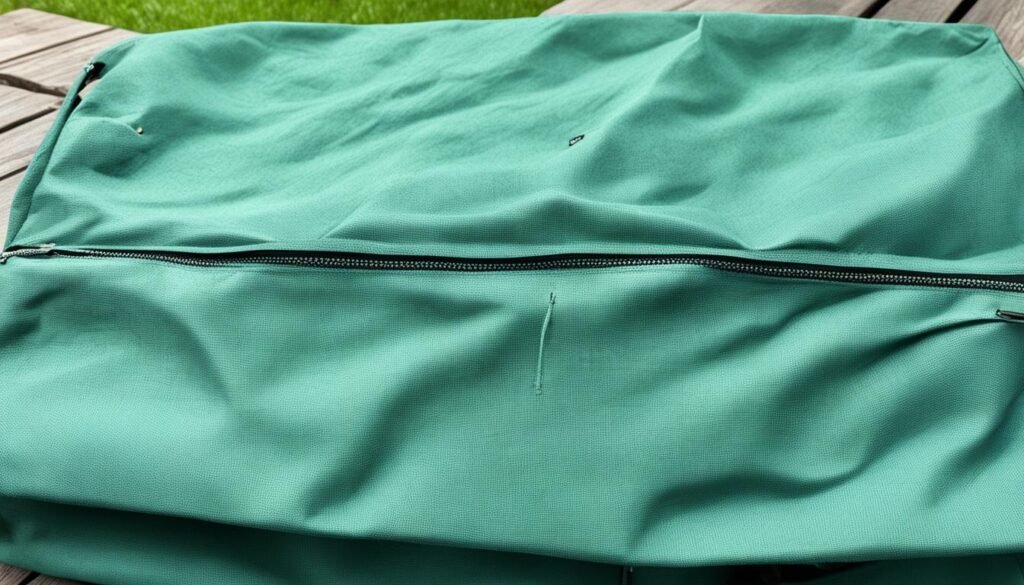
| Pros of Repairing a Tent Bag | Cons of Repairing a Tent Bag |
|---|---|
| Cost-effective compared to purchasing a new bag | May not restore the bag’s original strength or durability |
| Eco-friendly option by extending the bag’s lifespan | Repair quality may vary based on the chosen repair service |
| Preserves bag sentimental value if it holds personal memories | Repair time may lead to extended waiting periods and inconvenience |
Ultimately, the decision to repair or replace a damaged tent bag depends on the severity of the damage, personal preferences, and cost considerations.
Expert Tips and Additional Resources
As a camping enthusiast, I want to share some expert tips and provide you with additional resources to help you take care of your tent and enhance your camping experience. Follow these tips and explore the resources listed below to make the most of your outdoor adventures.
Airing Out Your Tent
After each camping trip, it’s important to air out your tent to prevent any unpleasant odors or mildew growth. Simply set up your tent in a well-ventilated area, preferably in the shade, and leave it open for a few hours to allow fresh air to circulate.
Cleaning Your Tent
To keep your tent in top condition, regular cleaning is essential. Use a soft brush or sponge to remove any dirt or debris from the tent’s exterior. For stubborn stains, a mild soap solution can be used. Avoid using harsh chemicals or abrasive cleaners, as they can damage the tent’s waterproof coatings and fabrics.
Repairing with Duct Tape
Duct tape is a camper’s best friend when it comes to temporary tent repairs. If you notice a small tear or hole in your tent fabric, a patch of duct tape can provide a quick fix until you can properly repair it. Make sure to clean and dry the area before applying the tape for the best adhesion.
Protecting with Footprints
A footprint is a specially designed groundsheet that fits perfectly under your tent. It provides an extra layer of protection against rough terrain, sharp objects, and moisture. Investing in a good quality footprint can extend the lifespan of your tent by preventing wear and tear on the tent’s floor.
The Importance of Seam Sealant
Seams are the most vulnerable areas of a tent when it comes to leaks. Seam sealant is a waterproofing product that can be applied to the tent’s seams to enhance their durability and prevent water from seeping through. Regularly inspect the seams and reapply sealant as needed to maintain the tent’s waterproofness.
Recommended Resources
Explore these resources for tent accessories, repair kits, and waterproofing products:
| Resource | Description |
|---|---|
| Outdoor Gear Lab | A comprehensive website that provides reviews and recommendations for the best tent accessories and gear. |
| REI | A trusted outdoor retailer offering a wide selection of tent accessories, including footprints, repair kits, and seam sealants. |
| Backcountry | An online marketplace that offers a variety of tent accessories, repair kits, and waterproofing products from different brands. |
By following these expert tips and utilizing the resources available, you can effectively care for and maintain your tent, ensuring its longevity and optimal performance during your camping adventures.
Conclusion
In conclusion, mastering the skill of folding a tent back into its bag and properly storing it is crucial for campers and outdoor enthusiasts. By following the step-by-step instructions and tips provided in this guide, you can ensure efficient use of storage space, maintain the tent’s condition, and streamline the setup and takedown process during camping trips.
Properly folding and storing your tent not only maximizes its lifespan and performance but also guarantees a hassle-free experience on your future outdoor adventures. Taking care of your tent is essential, as it will take care of you in return.
Remember to clean and dry your tent before storage to prevent mold and mildew growth. Check for any damage and make necessary repairs to prolong the life of your tent. Choose the appropriate folding or stuffing method based on your personal preference and tent type. Store your tent in a cool and dry place, away from direct sunlight, and periodically check on it to ensure its condition remains optimal.
By prioritizing proper storage and maintenance of your tent, you can enjoy many more memorable camping experiences while ensuring the longevity and reliability of your trusted outdoor shelter. Happy camping!
What is the Best Way to Fold a Tent and Pack It Away for Storage?
When it comes to tent packing tips after camping, the best way to fold a tent and pack it away for storage is to start by shaking off any dirt or debris. Then, fold the tent into a rectangular shape and roll it tightly to ensure a compact and organized storage.
Would the same folding technique work for both pop-up tents and traditional tents?
When it comes to stepbystep popup tent folding, the technique may vary between pop-up tents and traditional tents. Pop-up tents often require a specific method to collapse them back into their compact form, while traditional tents may involve a different set of steps to fold and store them properly.
FAQ
How do I prepare my tent before packing it away?
It is important to ensure that the tent is clean and dry. Shake off any loose dirt or debris and allow the tent to thoroughly air-dry to prevent the growth of mold and mildew.
How do I remove the pegs and poles from the tent?
Start by removing all the outer pegs from the ground using a “twist and pull” method or a peg extractor. Remove the poles according to the recommended order, usually starting from the outside and working inwards.
What final checks should I make before folding the tent?
Double-check if any pegs are left in the ground and remove them. Clean and towel dry the poles and pegs if necessary. Ensure that the ropes or webbing straps are dry before folding to prevent dye transfer or mildew.
What is the folding method for tents?
Without standing on the fabric, fold the tent in half and then back on itself. Alternatively, you can detach the ropes temporarily to avoid tangling. Ensure that the ropes or webbing straps are dry before folding to prevent dye transfer or mildew.
How do I complete the final folding stage?
Fold the tent in half lengthwise and roll it tightly, smoothing and releasing air as you go. Use the provided straps to clip the rolled-up tent into place. Consider using an “XL Kit Bag” for extra storage space if needed.
How do I put the tent into the bag?
To ensure the tent fits back into the bag, place the bag at the end of the tent and check if the width is small enough. Adjust the folding technique if necessary. It is important to use a properly sized bag to avoid stress on the fabric and zippers.
Should I store a wet tent?
No, it is not advisable to store a wet or damp tent as it can lead to mold and mildew growth, fabric degradation, stains, and foul smells. Thoroughly clean and dry the tent before storage.
How do I check for damage and repair my tent?
Before packing the tent, carefully inspect it for any damage such as rips or tears. Minor damage can be repaired using a tent repair kit or duct tape. Severe damage may require replacing parts or the entire tent.
Should I fold or stuff my tent for storage?
The choice between folding and stuffing a tent depends on personal preference and the type of tent. Folding neatly minimizes creases and wrinkles, while stuffing is convenient. Consider the advantages and disadvantages of each method.
How should I store my tent after camping?
Clean and dry the tent thoroughly, remove stakes and guy lines, and either fold or roll the tent properly. Find a cool, dry, and well-ventilated place for storage, preferably in a storage bag or sack that allows for air circulation.
Do I need to periodically check on my stored tent?
Yes, it is important to periodically check on your stored tent to ensure it remains dry and in good condition. Take measures to prevent pests and avoid excessive compression or storing in direct sunlight.
What should I do if my tent bag is damaged?
It is important to have a proper tent bag to protect and transport your tent. If the tent bag gets damaged, you can repair it or replace it by using third-party recommended repair companies or purchasing spare parts from the manufacturer.
Are there any expert tips and resources for tent care?
Yes, we have additional tips on airing out the tent, cleaning it, using duct tape for repairs, using footprints for protection, and the importance of seam sealant. You can also find a wide range of tent accessories, repair kits, and waterproofing products available in the market.

